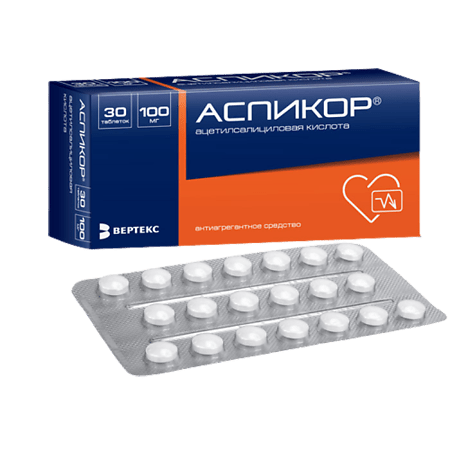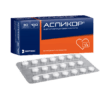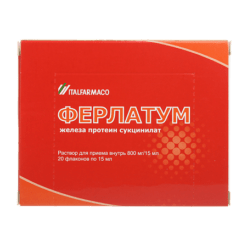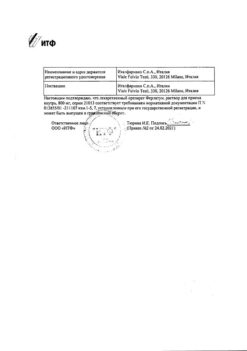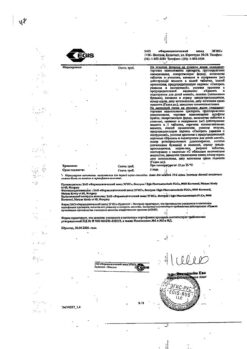No products in the cart.
Aspicor, 100 mg 30 pcs
€3288.00 €2.74
Description
Aspicor® due to the active ingredient – acetylsalicylic acid – has an antiplatelet effect when used in low doses for a long time.
The main mechanism of action of acetylsalicylic acid is non-selective inactivation of cyclooxygenase enzyme (COX), resulting in disruption of synthesis of prostaglandins, prostacyclins by endothelial cells (in doses over 300 mg) and thromboxane A2 in platelets, which determines antiplatelet action of the drug.
Acetylsalicylic acid may have other effects on blood clotting by increasing fibrinolytic activity and reducing the concentration in blood of vitamin K-dependent clotting factors (II, VII, IX, X).
Indications
Indications
– Prevention of acute myocardial infarction in the presence of risk factors (eg, diabetes, hyperlipidemia, hypertension, obesity, smoking, old age), recurrent myocardial infarction and suspected acute myocardial infarction.
– Unstable angina pectoris.
– Prevention of stroke (including in patients with transient cerebral circulation disorder).
– Prevention of transient impairment of cerebral circulation.
– Prevention of thromboembolism after operations and invasive vascular interventions (e.g., coronary artery bypass grafting, carotid endarterectomy, arterio-venous bypass, carotid angioplasty).
– Prevention of deep vein thrombosis and thromboembolism of the pulmonary artery and its branches (for example, in case of prolonged immobilization as a result of major surgical intervention).
Active ingredient
Active ingredient
Composition
Composition
1 enteric-coated tablet contains:
The active ingredient:
acetylsalicylic acid – 0.1 g.
Associates:
microcrystalline cellulose,
lactose monohydrate,
croscarmellose sodium,
silicon dioxide colloid (aerosil),
stearic acid.
Quietly soluble coating:
Methacrylic acid and ethylacrylate copolymer (methacrylic acid copolymer),
propylene glycol,
macrogol 4000 (polyethylene glycol 4000,
polyethylene oxide 4000),
titanium dioxide,
talc.
How to take, the dosage
How to take, the dosage
Aspicor® should be taken orally before meals, without chewing, with plenty of fluid. The drug is intended for long-term use. The duration of therapy is determined by the attending physician.
In case of suspected acute myocardial infarction
100-200 mg/day (the first tablet should be chewed to aid absorption).
The prevention of primary acute myocardial infarction in the presence of risk factors is 100 mg/day.
Prevention of recurrent myocardial infarction. Unstable angina pectoris. Prevention of stroke and transient cerebral circulation disorder. Prevention of thromboembolic complications after surgical operations or invasive investigations – 100-300 mg/day.
Prevention of deep vein thrombosis and thromboembolism of the pulmonary artery and its branches – 100-200 mg/day.
Interaction
Interaction
Aspikor® when used concomitantly increases the effect of the following medicines:
– methotrexate due to decreased renal clearance and its displacement from binding to plasma proteins;
– heparin and indirect anticoagulants due to disruption of platelet function and displacement of indirect anticoagulants from binding to plasma proteins;
– thrombolytics and antiplatelet agents (ticlopidine).
– Digoxin due to the decrease of its renal excretion. – Hypoglycemic drugs (insulin and sulfonylurea derivatives) due to the hypoglycemic properties of acetylsalicylic acid at high doses and displacement of sulfonylurea derivatives from plasma proteins;
– valproic acid due to its displacement from plasma protein binding;
– other non-steroidal anti-inflammatory drugs;
– hypotensive drugs, diuretics (spironolactone, furosemide).
The combination of acetylsalicylic acid with anticoagulants, thrombolytics and antiaggregant drugs is accompanied by an increased risk of bleeding.
The combination of acetylsalicylic acid with methotrexate is accompanied by an increased frequency of side effects from the hematopoietic organs.
Ethanol and ethanol-containing medications increase damaging effects on the gastrointestinal mucosa, increase the risk of gastrointestinal bleeding. Acetylsalicylic acid weakens the effect of uricosuric drugs (benzbromaron, sudafinpyrazone) due to competitive tubular elimination of uric acid.
By enhancing the elimination of salicylates, systemic glucocorticosteroids (GCS) weaken their effects. Increases the concentration of digoxin, barbiturates, lithium salts in plasma.
Antacids containing magnesium and/or allium slow down and impair absorption of acetylsalicylic acid. Myelotoxic drugs increase the manifestations of hematotoxicity of the drug.
Special Instructions
Special Instructions
Acetylsalicylic acid may provoke bronchospasm, as well as causing attacks of bronchial asthma and other hypersensitivity reactions. Risk factors include a history of bronchial asthma, hay fever, nasal polyposis, chronic respiratory diseases, and allergic reactions to other medications (e.g., skin reactions, itching, urticaria).
Acetylsalicylic acid may cause bleeding of varying severity during and after surgical interventions.
Acetylsalicylic acid in low doses may provoke the development of gout in predisposed persons (who have reduced excretion of uric acid).
High doses of acetylsalicylic acid have a hypoglycemic effect, which should be kept in mind when prescribing it to patients with diabetes who receive hypoglycemic drugs.
When using GCS and salicylates in combination it should be remembered that during treatment the concentration of salicylates in blood is decreased and after withdrawal of GCS an overdose of salicylates is possible.
The combination of acetylsalicylic acid with ibuprofen is not recommended because the latter worsens the beneficial effects of Aspicorà on longevity.
Exceeding the dose of acetylsalicylic acid carries a risk of gastrointestinal bleeding.
Impact on driving and operating machinery
During the use of the drug, caution should be exercised while driving vehicles and engaging in other potentially dangerous activities requiring increased concentration and rapid psychomotor reactions.
Features
Features
Contraindications
Contraindications
– Hypersensitivity to the components of the drug and other nonsteroidal anti-inflammatory drugs (NSAIDs).
– Erosive and ulcerative lesions of the gastrointestinal tract; gastrointestinal bleeding.
– Hemorrhagic diathesis.
– Bronchial asthma, induced by receiving salicylates and NSAIDs, Fernand-Vidal triad (complete or incomplete combination of bronchial asthma, recurrent polyposis of the nose and sinuses and intolerance to acetylsalicylic acid).
– Combined use with methotrexate at a dose of 15 mg per week or more.
– Lactase deficiency, lactose intolerance, glucose-galactose malabsorption.
– Pregnancy (I and III trimester) and lactation.
– Age under 18 years.
Side effects
Side effects
Allergic reactions (urticaria, Quincke’s edema), anaphylaxis;
Nausea, heartburn, vomiting, abdominal pain, gastric and duodenal ulcers, including perforation. with perforation, gastrointestinal bleeding;
increased activity of “liver” enzymes; bronchospasm;
High bleeding, anemia;
dizziness, tinnitus.
Overdose
Overdose
Symptoms (single dose of less than 150 mg/kg – acute poisoning is considered mild, 150-300 mg/kg – moderate, more than 300 mg/kg – severe): salicyl syndrome (nausea, vomiting, tinnitus, visual disturbances, dizziness, severe headache, general malaise, fever – poor prognostic sign in adults). Severe poisoning – central pulmonary hyperventilation, respiratory alkalosis, metabolic acidosis, confusion, drowsiness, collapse, seizures, anuria, bleeding. Initially, central hyperventilation of the lungs leads to respiratory alkalosis – shortness of breath, shortness of breath, cyanosis, cold clammy sweat; with increasing intoxication, respiratory paralysis and dissociation of oxidative phosphorylation increase, causing respiratory acidosis.
In chronic overdose the concentration determined in plasma correlates poorly with the severity of intoxication. The highest risk of chronic intoxication is noted in elderly patients when taking more than 100 mg/kg/day for several days. In elderly patients, the initial signs of salicylation are not always visible, so it is advisable to periodically determine the content of salicylates in blood: a concentration above 70 mg% indicates moderate or severe intoxication; above 100 mg% – extremely severe, prognostically unfavorable. Hospitalization is necessary for moderate to severe trauma.
Treatment:
Provocation of vomiting, prescription of activated charcoal and laxatives, constant control of acid-base state and electrolyte balance; depending on the state of metabolism – administration of sodium hydrocarbonate, sodium citrate solution or sodium lactate. Increasing reserve alkalinity enhances excretion of acetyl-salicylic acid by alkalizing the urine.
L urine alkalinization is indicated at salicylate concentrations above 40 mg% and is achieved by an IV infusion of sodium hydrocarbonate (88 mEq in 1 liter of 5% dextrose solution, at a rate of 10-15 ml/h/kg); restoration of circulating blood volume and induction of diuresis is achieved by sodium hydrocarbonate infusion in the same doses and dilutions, which is repeated 2-3 times.
Caution should be exercised in elderly patients in whom intensive fluid infusion may result in pulmonary edema. The use of acetazolamide to alkalize the urine is not recommended (may cause acidosis and increase the toxic effects of salicylates).
Hemodialysis is indicated at salicylate concentrations above 100-130 mg%, in patients with chronic poisoning – 40 mg% or lower, if indicated (refractory acidosis, progressive deterioration of condition, severe central nervous system damage, pulmonary edema and renal failure). In case of pulmonary edema – artificial lung ventilation with a mixture enriched with oxygen.
Pregnancy use
Pregnancy use
The use of high doses of salicylates in the first 3 months of pregnancy is associated with an increased incidence of fetal defects (cleft palate, heart defects). In the second trimester of pregnancy, salicylates may be prescribed only with a strict assessment of the risks to the fetus and the benefits to the mother.
In the last trimester of pregnancy, salicylates at high doses (over 300 mg/day) cause inhibition of labor, premature closure of the fetal arterial duct, increased bleeding in the mother and fetus, and administration just before delivery can cause intracranial hemorrhages, especially in premature babies. Prescribing salicylates in the last trimester of pregnancy is contraindicated.
Salicylates and their metabolites pass into breast milk in small amounts.
Similarities
Similarities
Additional information
| Shelf life | 2 years |
|---|---|
| Conditions of storage | In a light-protected place at a temperature not exceeding 25 °C. |
| Manufacturer | Vertex, Russia |
| Medication form | enteric soluble tablets |
| Brand | Vertex |
Related products
Buy Aspicor, 100 mg 30 pcs with delivery to USA, UK, Europe and over 120 other countries.

